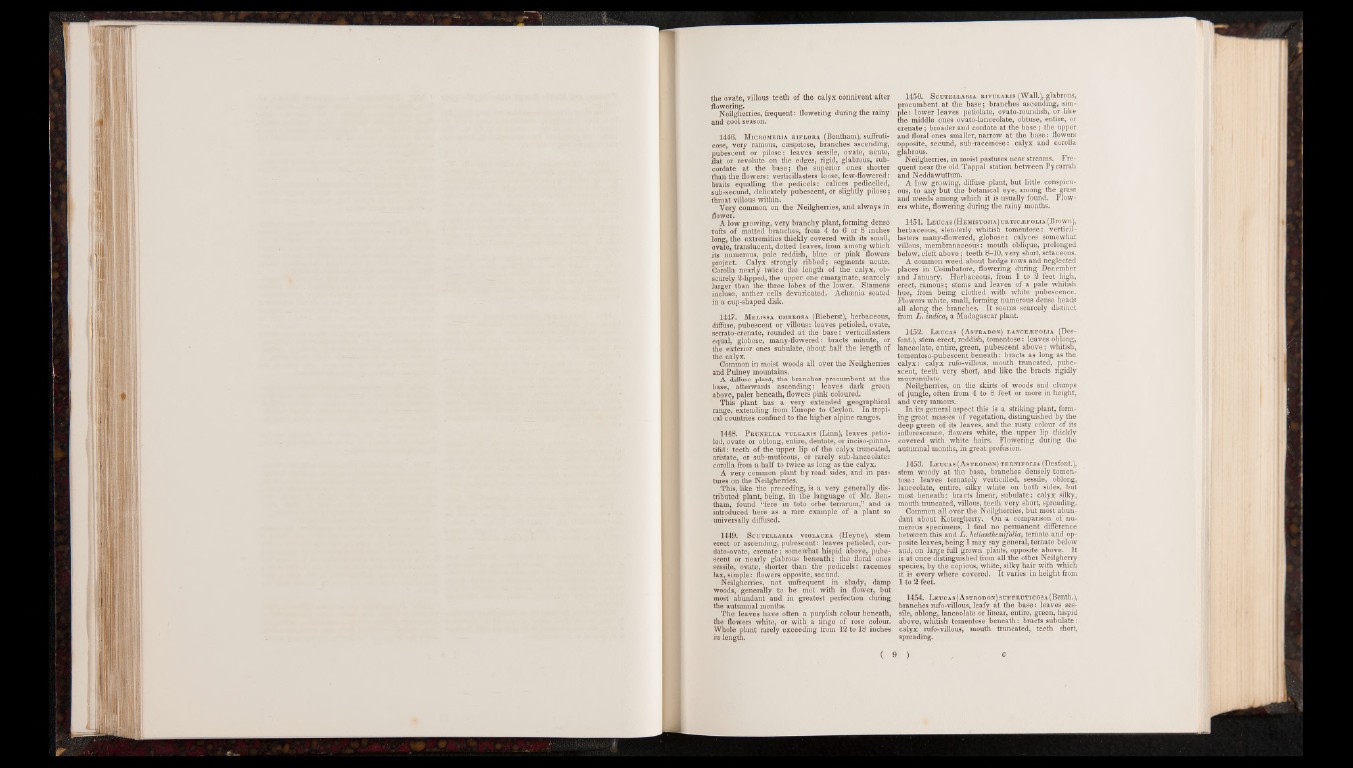
the ovate, villous teeth of the calyx connivent after
flowering.
Neilgherries, frequent: flowering during the rainy
and cool season.
1446. Micromeria biflora (Bentham), suffruti-
cose, very ramous, caespitose, branches ascending,
pubescent or pilose: leaves sessile, ovate, acute,
flat or revolute on the edges, rigid, glabrous, sub-
cordate at the base; the superior ones shorter
than the flowers: verticillasters loose, few-flowered:
braits equalling the pedicels: calices pedicelled,
sub-secund, delicately pubescent, or slightly pilose;
throat villous within.
Very common on the Neilgherries, and always in
flower.
A low growing, very branchy plant, forming dense
tufts of matted branches, from 4 to 6 or 8 inches
long, the extremities thickly covered with its small,
ovate, translucent, dotted leaves, from among which
its numerous, pale reddish, blue or pink flowers
project. Calyx strongly ribbed; segments acute.
Corolla nearly twice the length of the calyx, obscurely
2-lipped, the upper one emarginate, scarcely
larger than the three lobes of the lower. Stamens
induse, anther cells devaricated. Achaenia seated
in a cup-shaped disk.
1447. Melissa ombrosa (Bieberst), herbaceous,
diffuse, pubescent or villous: leaves petioled, ovate,
serrato-crenate, rounded at the base: verticillasters
equal, globose, many-flowered: bracts minute, or
the exterior ones subulate, about half the length of
the calyx.
Common in moist woods all over the Neilgherries
and Pulney mountains.
A diffuse plant, the branches procumbent at the
base, afterwards ascending: leaves dark green
above, paler beneath, flowers pink coloured.
This plant has a very extended geographical
range, extending from Europe to Ceylon. In tropical
countries confined to the higher alpine ranges.
1448. Prunella vulgaris (Linn), leaves petioled,
ovate or oblong, entire, dentate, or inciso-pinna-
tifid: teeth of the upper lip of the calyx truncated,
aristate, or sub-muticous, or rarely sub-lanceolate:
corolla from a half to twice as long as the calyx.
A very common plant by road sides, and in pastures
on the Neilgherries.
This, like the preceding, is a very generally distributed
plant, being, in the language of Mr. Bentham,
found “fere in toto orbe terrarum,” and is
introduced here as a rare example of a plant so
universally diffused.
1449. Scutellaria violacea (Heyne), stem
erect or ascending, pubescent: leaves petioled, cor-
dato-ovate, crenate; somewhat hispid above, pubescent
or nearly glabrous beneath; the floral ones
sessile, ovate, shorter than the pedicels: racemes
lax, simple: flowers opposite, secund.
Neilgherries, not unfrequent in shady, damp
woods, generally to be met with in flower, but
most abundant and in greatest perfection during
the autumnal months.
The leaves have often a purplish colour beneath,
the flowers white, or with a tinge of rose colour.
Whole plant rarely exceeding from 12 to 18 inches
in length.
1450. S cutellaria rivularis (Wall.), glabrous,
procumbent at the base; branches ascending, simple:
lower leaves petiolate, ovato-roundish, or like
the middle ones ovato-lanceolate, obtuse, entire, or
crenate; broader and cordate at the b a se ; the upper
and floral ones smaller, narrow at the base: flowers
opposite, secund, sub-racemose: calyx and corolla
glabrous.
Neilgherries, in moist pastures near streams. Frequent
near the old Tappal station between Pycarrah
and Neddawuttum.
A low growing, diffuse plant, but little conspicuous,
to any but the botanical eye, among the grass
and weeds among which it is usually found. Flowers
white, flowering during the rainy months.
1451. Leucas (Hemistoma) urticjefolia (Brown),
herbaceous, slenderly whitish tomentose: verticillasters
many-flowered, globose: calyces somewhat
villous, membranaceous: mouth oblique, prolonged
below, cleft above; teeth 8-10, very snort, setaceous.
A common weed about hedge rows and neglected
places in Coimbatore, flowering during December
and January. Herbaceous, from 1 to 2 feet high,
erect, ramous; stems and leaves of a pale whitish
hue, from being clothed with white pubescence.
Flowers white, small, forming numerous dense heads
all along the branches. It seems scarcely distinct
from L . indica, a Madagascar plant.
1452. Leucas (Astradon) lancejefolia (Des-
font.), stem erect, reddish, tomentose: leaves oblong,
lanceolate, entire, green, pubescent above; whitish,
tomentoso-pubescent beneath: bracts as long as the
calyx: calyx rufo-villous, mouth truncated, pubescent,
teeth very short, and like the bracts rigidly
mucronulate.
Neilgherries, on the skirts of woods and clumps
of jungle, often from 4 to 8 feet or more in height,
and very ramous.
In its general aspect this is a striking plant, forming
great masses of vegetation, distinguished by the
deep green of its leaves, and the rusty colour of its
inflorescence, flowers white, the upper lip thickly
covered with white hairs. Flowering during the
autumnal months, in great profusion.
1453. Leucas (Astrodon) ternifolia (Desfont.),
stem woody at the base, branches densely tomentose:
leaves ternately verticilled, sessile, oblong,
lanceolate, entire, silky white on both sides, but
most beneath: bracts linear, subulate: calyx silky,
mouth truncated, villous, teeth very short, spreading.
Common all over the Neilgherries, but most abundant
about Kotergherry. On a comparison of numerous
specimens, I find no permanent difference
between this and L . helianthemifolia, ternate and opposite
leaves, being I may say general, ternate below
and, on large full grown plants, opposite above. It
is at once distinguished from all the other Neilgherry
species, by the copious, white, silky hair with which
it is every where covered. It varies in height from
1 to 2 feet.
1454. Leucas (Astrodon) suFFRUTicosA(Benth.),
branches rufo-villous, leafy at the base: leaves sessile,
oblong, lanceolate or linear, entire, green, hispid
above, whitish tomentose beneath: bracts subulate:
calyx rufo-villous, mouth truncated, teeth short,
spreading.
9 9 )